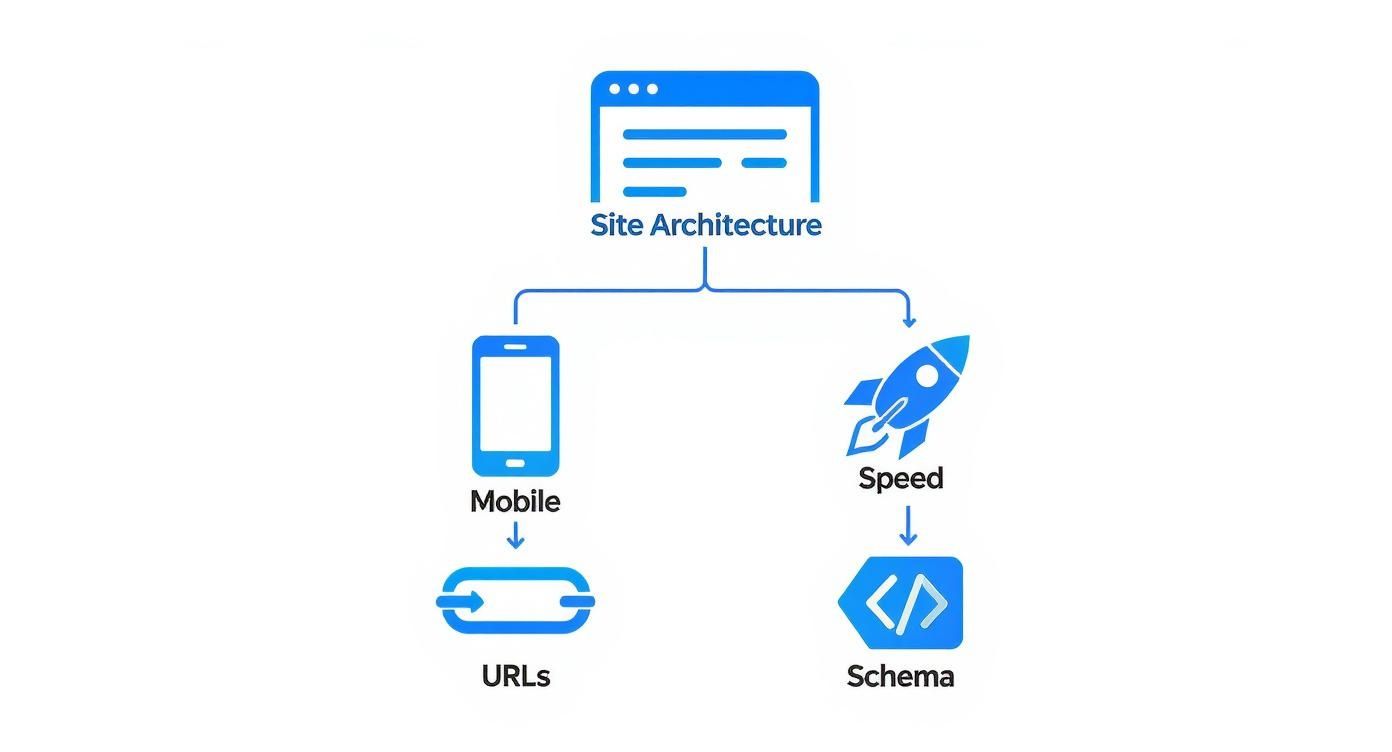For a technology company, search engine optimization (SEO) is more than a marketing tactic—it's a direct channel to customers actively seeking your solutions. In a crowded marketplace, a well-executed SEO strategy acts as a powerful growth engine, building your brand’s authority and generating a reliable stream of high-intent leads.
Why SEO Is Your Tech Company's Growth Engine

In the tech world, your audience is often skeptical, well-informed, and tackling complex problems. They don't make impulse buys; they conduct deep research to find a solution they can truly depend on.
This is precisely where a strong SEO for technology companies strategy becomes your greatest asset. It positions you as the definitive answer at the exact moment a potential customer needs one. Unlike paid advertising, which disappears when the budget runs out, a strong organic presence is a lasting asset that builds sustainable growth.
Building Trust Through Authority
Tech buyers can spot marketing fluff from a mile away. They seek genuine expertise and validation, which SEO delivers by placing your most insightful content—technical guides, in-depth product comparisons, and detailed case studies—directly in their path.
When your website consistently appears as a top result for their complex queries, you transition from being just another vendor to a trusted authority. This approach is invaluable for the long sales cycles common in B2B tech, as your content nurtures potential leads by educating them and building confidence long before they ever speak to a salesperson.
A well-executed SEO strategy does more than attract visitors; it pre-qualifies them. By the time they reach out, they already understand your value and see you as a credible partner.
The Unmissable Power of Organic Search
The data is clear: over 90% of online experiences begin with a search engine, and organic results capture about 70% of all user clicks. Even more telling is that 75% of users never scroll past the first page. Your presence there isn't just a nice-to-have—it's essential for survival and growth.
This visibility translates directly into measurable business results:
- Predictable Lead Generation: Attract a consistent stream of users with high purchase intent.
- Sustainable Competitive Advantage: Carve out a defensible market position that competitors can't easily replicate with ad spend.
- Lower Customer Acquisition Costs: Over time, SEO consistently delivers a higher ROI than paid channels by generating "free" traffic.
Ignoring organic search is like handing your most valuable prospects to the competition. With the right approach, SEO can become the most important acquisition channel for any SaaS, software, or hardware company seeking long-term success. If you're weighing the pros and cons, you might find our detailed guide on whether SEO is worth the investment helpful.
Building a Rock-Solid Technical SEO Foundation
Before you write a single blog post, the technical health of your website sets the stage for success. Think of technical SEO as the foundation of a skyscraper—if it's cracked, everything built on top is at risk. For a tech company, this isn't just about satisfying search engines; it’s about delivering a flawless user experience that reflects the quality of your product.
A clunky, slow, or confusing site sends a clear signal that your brand might be just as frustrating to work with. Nailing this groundwork is a non-negotiable first step in any serious SEO for technology companies strategy.
Prioritize Performance and User Experience
In technology, speed is a feature. A slow-loading website is more than an annoyance; it's a direct reflection of your company’s competence. If your site lags, prospects will wonder if your software is just as sluggish.
Google has made it clear that site speed and user experience are major ranking factors, encapsulated in a set of metrics called Core Web Vitals. These measure how quickly your page loads, how fast users can interact with it, and whether the layout is stable. A poor score here can actively suppress your rankings.
For a deeper dive into these critical metrics, we have prepared a comprehensive guide explaining Core Web Vitals in detail, which can help you pinpoint specific areas for improvement.
A Logical Architecture for Complex Products
Technology companies often have massive websites with complex product features, multiple solutions, and sprawling documentation hubs. Without a logical site structure, this valuable information becomes a confusing maze for both users and search engine crawlers.
A clean architecture functions like a library's categorization system, enabling visitors to find what they need quickly.
This boils down to a few key elements:
- Clean URL Structures: Your URLs should be simple and descriptive. For example,
yourcompany.com/solutions/cybersecurity-monitoringis far superior toyourcompany.com/prod?id=875&cat=sol_4. - Logical Internal Linking: Connect related content. A blog post on API security should link to your API security product page, guiding users and distributing page authority throughout your site.
- Breadcrumbs: These navigational aids show users their location on your site and are especially helpful for deep documentation or resource sections.
A well-planned site architecture ensures your most important pages are easy to find, signaling their value to search engines and smoothing the user's journey from discovery to conversion.
The Strategic Power of Schema Markup
Schema markup is specialized code added to your website to give search engines deeper contextual understanding of your content. For a tech company, this is a powerful tool that can make your search results stand out.
Instead of a plain blue link, schema can generate "rich results" that display key information directly on the search page, grabbing attention and significantly boosting your click-through rate.
Consider implementing these essential schema types:
By perfecting these technical elements, you create a seamless experience that builds trust and authority. This strong foundation makes every piece of content and every marketing campaign that follows significantly more effective.
Mastering Keyword Strategy for a Technical Audience
Effective SEO for a technology company requires a deep understanding of the technical B2B buyer's journey. It's not a straight line but a winding road filled with complex problem-solving, thorough research, and multiple stakeholders.
Your keyword strategy must reflect this reality. It needs to map your content to every question, pain point, and "aha!" moment along the way. Think beyond individual keywords and consider the entire conversation your ideal customer is having, starting long before they’ve heard of your brand.
Beyond the Buzzwords: Intent is Everything
At the heart of any successful keyword strategy is user intent. You must understand why a user is typing a specific phrase into Google. Are they just learning about a problem? Actively comparing solutions? Or ready to request a demo?
For example, someone searching "how to automate customer support" is at the beginning of their journey and needs educational content. In contrast, a user searching "Zendesk vs Intercom pricing" is much further down the funnel with clear commercial intent. Your content must meet them exactly where they are.
The most powerful keyword strategies don’t just chase traffic; they attract qualified leads by precisely matching content to the user’s position in the buying cycle. This is how you generate leads, not just page views.
A winning strategy needs a healthy mix of content targeting these different intent types to build a funnel that works.
Mapping Keywords to the Buyer's Journey
Let's use a cybersecurity firm as an example. Targeting a broad term like "cybersecurity software" is inefficient. Instead, a structured plan that speaks to the entire decision-making process is needed.
This requires a thoughtful mix of keyword types:
- Informational Keywords: For top-of-funnel audiences just realizing they have a problem. Think "what is a zero-day exploit" or "common phishing attack methods." This content builds awareness and positions you as an expert.
- Commercial Investigation Keywords: For users evaluating solutions. They search for "best EDR solutions for small business" or "CrowdStrike vs SentinelOne comparison." This is your chance to guide them as they narrow their options.
- Transactional Keywords: For bottom-of-the-funnel, high-intent queries that signal someone is ready to buy. Searches like "get a quote for endpoint security" or "[Your Company] demo" are direct buying signals.
Of course, none of this matters without a solid technical foundation, which allows your keyword-targeted content to be discovered. The infographic below illustrates how core technical elements form the bedrock of your entire SEO effort.

This structure ensures that once you attract users with the right keywords, their on-site experience is flawless, building the trust needed to convert them into customers.
To help visualize this process, here’s a breakdown of how different keyword intents align with the buyer’s journey for a fictional B2B tech company.
Keyword Intent Mapping for a Technology Buyer's Journey
Mapping your keywords this way ensures you have relevant content ready for prospects at every stage of their decision-making process.
Uncovering Competitor Gaps and Long-Tail Opportunities
Your competitors provide a valuable roadmap. Analyzing the keywords they rank for reveals strategic gaps in your content plan. Tools like Ahrefs or Semrush are excellent for this analysis, showing you where to create superior content and capture their traffic.
Additionally, don't overlook long-tail keywords. These longer, more specific phrases may have lower search volume but often have incredibly high conversion rates. A search for "SOC 2 compliance automation software for startups" is far more valuable than a generic term like "compliance software."
Organizing related long-tail phrases into topic groups is a powerful technique. For a deep dive into this method, check out our guide on keyword clusters and how to use them to build true topical authority.
When you build a keyword strategy that speaks directly to the technical buyer's journey, you transform SEO from a basic traffic-driving tactic into a sophisticated machine for generating high-quality leads.
Creating High-Value Content That Actually Converts

In the tech sector, content is the currency of trust. Your audience of engineers, CTOs, and product managers is analytical and has a built-in radar for marketing fluff. Generic, keyword-stuffed articles won't just be ignored; they'll damage your credibility.
Effective SEO for technology companies means creating genuinely useful content. You need to produce resources that solve real-world problems, showcase your deep expertise, and build a compelling case for your product without an overt sales pitch.
Go Beyond the Standard Blog Post
A blog is a great starting point, but a technical audience craves depth. To truly connect, your content strategy must embrace formats that deliver practical, in-depth information. These assets attract qualified leads and empower your sales team.
Prioritize these high-impact formats:
- Exhaustive Technical Guides: Create long-form tutorials that walk users step-by-step through solving a tough problem with your technology. This content both ranks well and builds trust.
- Head-to-Head Product Comparisons: Your prospects are already comparing you to the competition. Control the narrative with honest, detailed comparison pages that highlight your unique strengths and address tough questions.
- Insightful Case Studies: A compelling tech case study must detail the specific problem, the solution implemented, and the hard numbers. Use real data and quantifiable metrics to prove your value.
- Original Data Reports: Conduct your own research or a survey and publish the findings. This type of original content is a magnet for high-authority backlinks from journalists and industry blogs, significantly boosting your domain authority.
Translate Features into User Benefits
A common pitfall for tech companies is focusing on features without explaining why they matter. It's your job to connect your technology to the user's day-to-day problems.
Instead of saying you have "AI-powered analytics," explain that it allows them to "reduce false positive security alerts by 40%, saving their team five hours a week." That's a tangible benefit.
The golden rule of tech content is to sell the outcome, not the tool. A user doesn't want a drill; they want a hole in the wall. Focus your content on the "hole," and the value of your "drill" becomes self-evident.
This simple shift changes the conversation from "what our tool does" to "what you can achieve with our tool," which is what your potential customers truly care about.
Fuel the Entire Sales Funnel
A smart content strategy supports prospects at every stage of their journey. While top-of-funnel content builds awareness, it's the bottom-of-funnel pieces that handle objections and drive conversions.
Your keyword strategy and content creation must be perfectly synchronized. Content targeting "how-to" and "what is" queries builds an audience, while content targeting "[your brand] vs [competitor]" or "best [solution] for [industry]" captures users ready to buy. These are core pillars of any strong content marketing effort, and we dive deeper into them in our guide to content marketing best practices.
The proof is in the results. SaaS companies like Time Doctor have built massive growth engines almost entirely on organic search, generating 20,000 trials and 7,000 new customers every month from their content and SEO channels alone. This shows that creating high-value, problem-solving content is a direct path to revenue.
By building a library of authoritative, benefit-focused content, your website becomes an indispensable resource, solidifying your brand as an expert and smoothing the entire sales process.
Earning Authority with Strategic Link Building
For a technology company, authority is a non-negotiable asset. A strong backlink profile is one of Google’s most powerful signals of trust, making strategic link building a core component of any serious SEO for technology companies strategy.
This isn't about acquiring low-quality links. It's about earning endorsements from respected voices in your industry. Each backlink acts as a vote of confidence. A link from a major tech publication or a key integration partner tells Google you're a legitimate authority, directly impacting your ability to rank for high-value commercial keywords.
Move Beyond Guest Posting
The old-school approach of mass guest posting is outdated and ineffective. Today’s link-building efforts must be more sophisticated, focusing on quality over quantity.
The goal has shifted to building relationships and creating assets that naturally attract links from sources that matter. This reframes link building from a tedious chore into a powerful brand-building exercise. Instead of just asking for links, you’re giving the industry a reason to talk about you.
Digital PR for Technology Companies
Digital PR is one of the most effective ways to earn top-tier, authoritative backlinks. It involves creating newsworthy content that journalists, bloggers, and industry analysts genuinely want to cover—a natural fit for innovative tech companies.
Consider these actionable digital PR strategies:
- Publish Original Research: Conduct a survey or analyze your proprietary data to uncover a unique trend. A report like "The State of AI Adoption in SMBs" becomes an invaluable resource that others will cite and link to.
- Run Campaigns for Feature Launches: A new product feature is a story waiting to be told. Frame your launch around a specific problem it solves and pitch that story to relevant tech news outlets.
- Offer Expert Commentary: Position your CTO or founder as a thought leader. Use services that connect journalists with expert sources to provide quotes and earn valuable brand mentions and links.
A single backlink from a top-tier industry publication like TechCrunch is worth more than hundreds of low-quality links. It’s a powerful signal of credibility that search engines can't ignore.
The Power of Linkable Assets
A "linkable asset" is a piece of content so valuable that other websites link to it organically. While original research is a prime example, other formats work exceptionally well for tech audiences.
You can learn more about the fundamentals of earning these links in our essential guide to link building for SEO, which unpacks these concepts in greater detail.
Focus on creating content that serves a clear, practical purpose for your audience.
By building a backlink profile rooted in genuine authority, you solidify your position as an industry leader, attracting both high-quality organic traffic and the trust of potential customers.
Measuring SEO Success with Metrics That Matter
How do you prove that your hard work is delivering results? A successful SEO for technology companies strategy cannot rely on vanity metrics like keyword rankings. Your executives want to see revenue, growth, and a clear return on investment.
To justify your budget and make smarter decisions, you must tie SEO performance directly to business outcomes. It's time to focus on the key performance indicators (KPIs) that truly matter to a tech company.
From Vanity Metrics to Business Impact
The real value of SEO isn't just getting more clicks—it's attracting the right audience and guiding them toward conversion. Your reporting must tell a story about bottom-of-the-funnel actions that directly fuel business growth.
Instead of leading with "organic traffic is up 20%," frame your results around tangible wins. This shift in perspective makes all the difference when communicating the true value of your efforts.
Start tracking and reporting on these key conversion points:
- Organic-Driven Demo Requests: The gold standard, directly showing how many high-intent prospects found you through search and are now asking to see your product.
- Trial Sign-Ups: For any SaaS business, the number of new trials from organic search is a clear indicator of how well your content resonates with the right audience.
- Marketing Qualified Leads (MQLs): Monitor how many organic leads are qualified enough to be passed to the sales team.
- Customer Acquisition Cost (CAC) from Organic: Calculate the cost to acquire a new customer through SEO. Over time, this number should be significantly lower than your paid channels, proving SEO's long-term ROI.
The most powerful SEO reports don't just list what happened. They weave a narrative about how organic search is filling the sales pipeline and bringing down customer acquisition costs. That's the language the C-suite speaks.
Building Your SEO Performance Dashboard
A well-designed dashboard provides an at-a-glance view of your SEO health and its impact on the business. Organize it logically, starting with big-picture business metrics and then drilling down into the data that explains why those numbers are what they are.
The global SEO software market was valued at USD 76.8 billion in 2024 and is projected to reach USD 299.6 billion by 2035. This explosive growth underscores the critical need for sophisticated analytics. You can discover more insights about the expanding SEO software market to see just how vital these tools have become.
Here’s a simple structure for your dashboard:
- Business Outcomes: Lead with what leadership cares about most: demo requests, trial sign-ups, and organic MQLs tracked over time.
- Top & Bottom Funnel Performance: Show how content is performing at every stage. Track conversions on high-intent pages (pricing, comparisons) and engagement on top-of-funnel content.
- Keyword & Ranking Health: Dig into rankings for your most valuable commercial keywords, your overall search visibility, and click-through rates.
- Technical & Authority Metrics: Include a snapshot of your site’s technical health (Core Web Vitals) and backlink growth to show how you're building a stronger domain.
This layered approach helps you tell a clear story about performance, back up your strategy with data, and continually identify opportunities for improvement.
At Twelverays, we believe great marketing is built on a foundation of data and a deep understanding of your business goals. We specialize in creating and executing SEO strategies that move beyond vanity metrics to deliver real, measurable growth for technology companies. If you're ready to build an organic search engine that fuels your sales pipeline and delivers a clear ROI, we're here to help. Learn more about how Twelverays can elevate your digital strategy.





